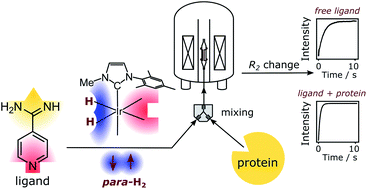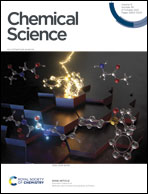Characterization of protein–ligand interactions by SABRE†
Abstract
Nuclear spin hyperpolarization through signal amplification by reversible exchange (SABRE), the non-hydrogenative version of para-hydrogen induced polarization, is demonstrated to enhance sensitivity for the detection of biomacromolecular interactions. A target ligand for the enzyme trypsin includes the binding motif for the protein, and at a distant location a heterocyclic nitrogen atom for interacting with a SABRE polarization transfer catalyst. This molecule, 4-amidinopyridine, is hyperpolarized with 50% para-hydrogen to yield enhancement values ranging from −87 and −34 in the ortho and meta positions of the heterocyclic nitrogen, to −230 and −110, for different solution conditions. Ligand binding is identified by flow-NMR, in a two-step process that separately optimizes the polarization transfer in methanol while detecting the interaction in a predominantly aqueous medium. A single scan Carr–Purcell–Meiboom–Gill (CPMG) experiment identifies binding by the change in R2 relaxation rate. The SABRE hyperpolarization technique provides a cost effective means to enhance NMR of biological systems, for the identification of protein–ligand interactions and other applications.

- This article is part of the themed collection: 2021 Chemical Science HOT Article Collection


 Please wait while we load your content...
Please wait while we load your content...